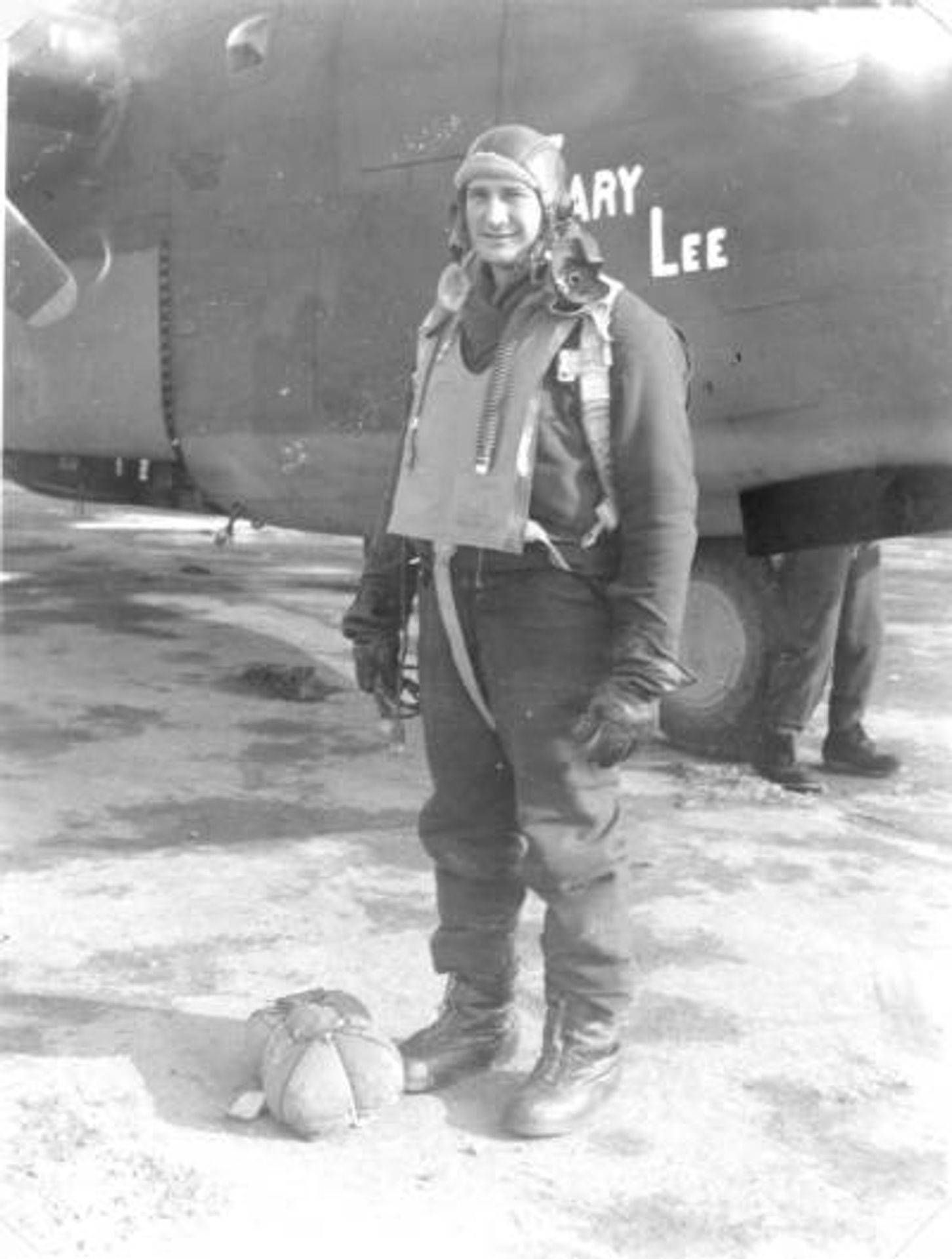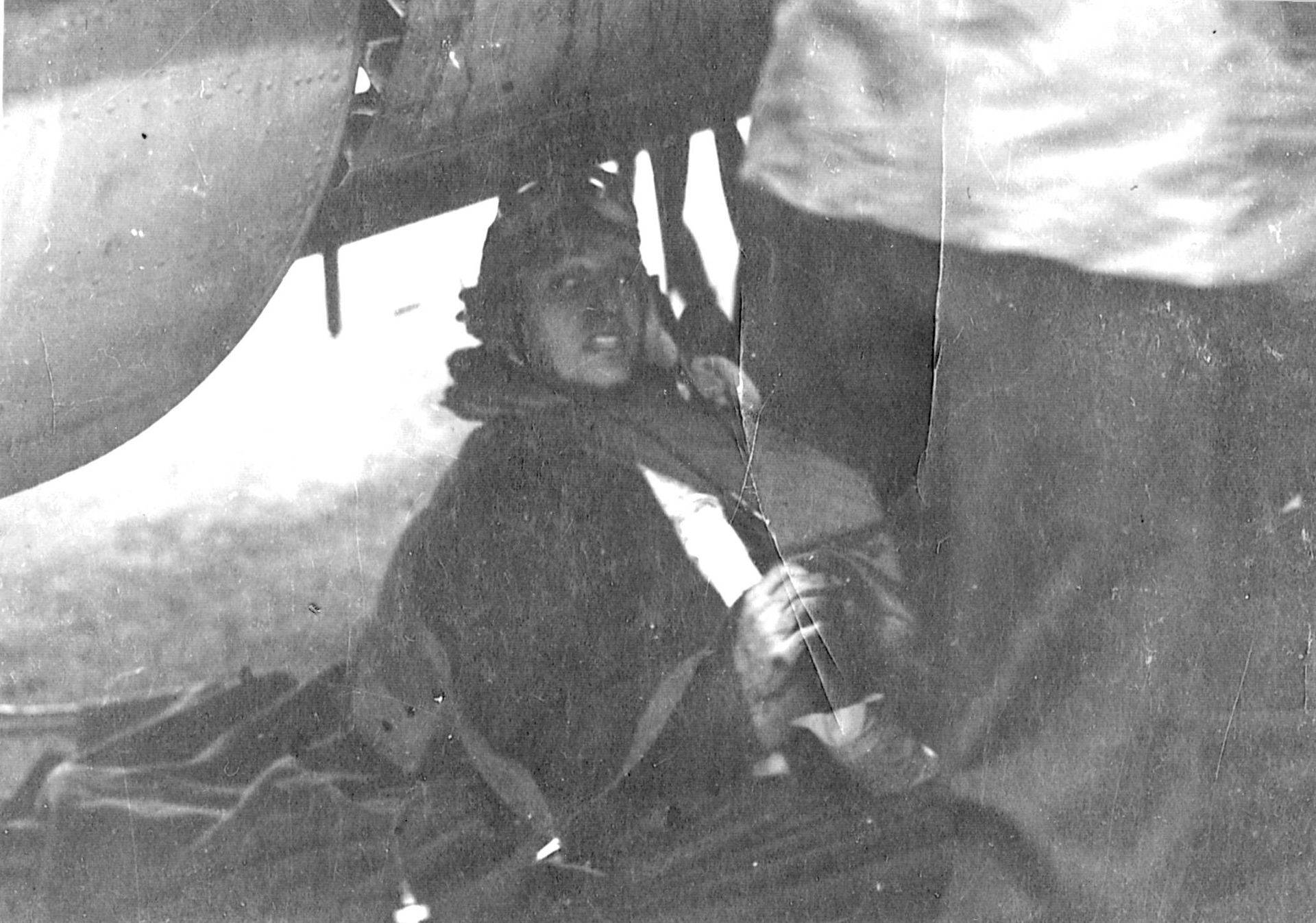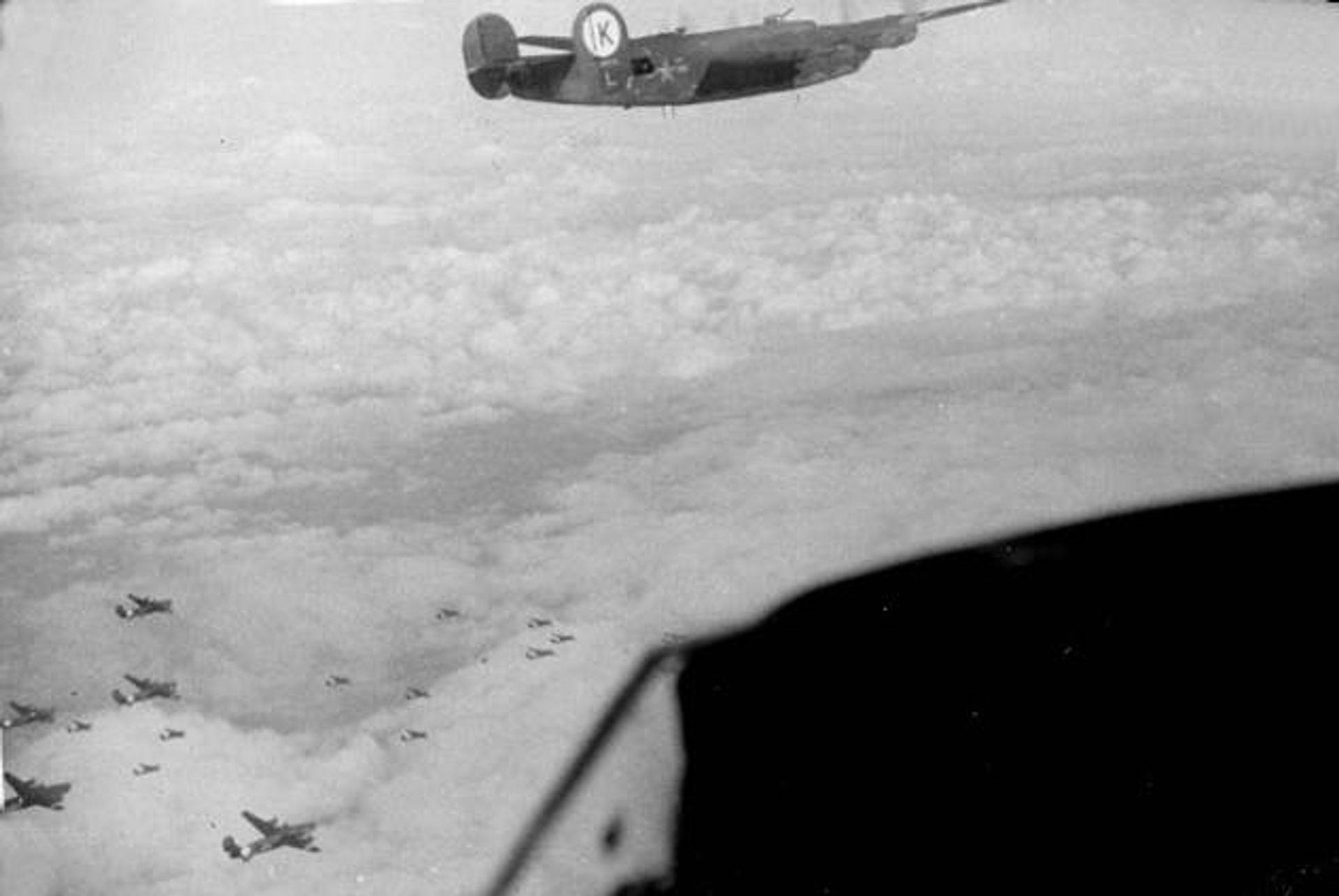458th Bombardment Group (H)
Mission Narrative
February and March 1944
458TH BOMBARDMENT GROUP (H)
HISTORY
FEBRUARY 1 to MARCH 31, 1944
Immediately upon our arrival at our new home in the UK, the Group settled down to prepare for the job we so eagerly awaited. To find ourselves the fortunate occupants of such a well equipped and planned base was beyond our fondest dreams, and our morale hit a new high.
A group meeting was called for all personnel at which time our CO, Lt. Col. ISBELL, outlined our aims, – what was expected of the group and the individual. He also stressed the importance of the individual’s conduct while a guest of our British Allies. Capt. HINKLE, the Base Provost Marshall, gave us some helpful hints on how to avoid the inevitable pitfalls that befall the GI when he first encounters strange people, places and customs.
While the aircraft were being modified, intensive ground training was started. Classes for the combat crews were held daily on all navigational subjects. The ground crew were extremely busy getting the aircraft ready for combat duty. All other personnel were busy setting up their departments, working with the RAF detachment who were to be our guides as well as friends until we were able to take over.
Daily lectures on security were given by the S-2 Section, and each member of the command was required to attend one of these lectures.
Officers and enlisted men started attending schools on special subjects at London and various stations in the UK. These subjects included: Intelligence Training, P/W Escape and Evasion, Target Identification, Radio Code and Cyphers. One hundred and twelve combat crew members attended Combat Gunnery School at Station 172. Training for all combat crews is still in progress, emphasis being placed on Target Identification.
Our first practice mission fell on 22 February, when the Group performed a camera bombing in the “WASH”. Actual battle conditions were simulated from briefing to interrogation.
On 23 Feb, another practice mission in the “WASH”, but we sensed the tenseness and the eagerness of the combat crews as well as all other personnel, to get into the “Big League” as soon as possible.
SUMMARY OF OPERATIONS
On 24 and 25 February, we participated in two diversionary missions to the coast of Holland and the occupied French Coast. The purpose of these mission[s] was to divert the enemy fighters from the main forces attacking targets in Germany. We were beginning to get “the scent”. “Diversionary missions [are] all well and good, but when are we going to get the real thing?” was the general question asked by all.

At last on 2 March we were to taste the fruits of our training and labor. This day we completed our first sortie on FRANKFURT. This was Mission #5, but our first accredited sortie. In high spirits, nineteen of our aircraft led by Lt. Col. ISBELL [pictured at left], dropped 286×100 M47 bombs on BIRNBACK and STAUDT, GERMANY. Fighter opposition was weak with but four FW 190’s attacking our formation. The fighters were driven off, and upon interrogating the crews, it was noted with some pride the nonchalant manner the crews described the fighter attacks. One would think they were veterans of hundreds of missions rather than airmen meeting the vaunted LUFTWAFFE for the first time. Their high feelings boded no good for the German fighters who would challenge them on their next mission. It was interesting to note their reaction to FLAK. It was the consensus of opinion “We just don’t like the damn stuff.” All aircraft returned to the base with but five planes showing minor battle damage.
The only incident marring the success of the mission was the crash on take-off of Plane No. 669, 752nd Sq. piloted by 2nd Lt. KENNETH MARKS GORRELL. Immediately upon take-off, the plane was seen to crash a short distance from the base around 0900 hours. The accident was thought to be due to insufficient flying speed, with the possibility of ice on wings. The aircraft was a total wreck, the crash causing slight damage to one residence, slight injuries to three residents and serious injury to another. Three of the crew members succeeded in escaping from the burning plane but the seven others perished. (See diary for names etc)
On 3 March we again took off to hit the DAIMLER-BENZ A/C works at ORANIENBURG, GERMANY. The formation of twenty planes was led by Major FEILING, followed by Major O’NEILL leading the Low section with Major HENSON leading the high. Jupiter Plutius favored the enemy this day, with the resultant record: No bombs dropped. It was a bitter pill to swallow to lose one plane without showing any material damage to the enemy to compensate for our loss, but we recorded: Missing in Action, Plane 298G, 755th Sq. Pilot 2nd Lt.FRANK W. HERZIK and crew. (See diary for names etc.)
From then on it seemed to be the accepted story “Alerted for Tonight”. We might say at this time we feel sure we hold the record for men who have attended a movie only to sit through half of it then be called away to load bombs. The less said about their remarks the better.
Once again on 6 March we were out in force, this time to strike another Aero Engine Works in BERLIN. This was Mission 9 Sortie 4. Here was the eagerly awaited magic word “Berlin!!!” When the target was announced the excited comments left no doubt of the electrifying effect the mere mention of the word had on the crews. The twenty seven plane formation, led by Lt. Col. ISBELL as command pilot of the lead section followed by Major O’NEILL as command pilot of the High Section took off for “BIG B”. One thousand and ninety two M47 IB’s were dropped in Target area, GENSHAGEN, and two hundred and eight M47’s dropped on a target of opportunity POTTSDAM. Although the fighter opposition was weak, the formation encountered terrific accurate flak, causing battle damage to seven aircraft. We suffered the greatest single loss of aircraft and personnel, losing five aircraft with fifty [crew] members missing. (See diary for names etc) Their loss was due to combined E/A and Flak.
Our effort this day gave us the distinction of being one of the groups who helped achieve the first large scale daylight attack against the German capital. Results were generally poor due to the unfavorable weather encountered. However, as some of the crew members stated, “at least we hit ‘Big B’ ”, and now that we know the way, we hope to be regular visitors.
After a day’s rest we were once again alerted on 8 March, this time to hit the VERLEINIGTE BALL BEARING WORKS at ERKNER, GERMANY. Mission 10, Sortie 5 saw our formation led by Major FEILING and Major LA ROCHE take off with 100 lb. GP’s. Bombs were dropped on the SE side of the town of Erkner with resultant large columns of smoke and fires visible at MPI. Although the smoke obscured the target, little doubt was left in our minds that the 128×100 GP’s and 210 M47 Clusters dropped helped immeasurably on the success of the mission. Plane No. 720, 755th Sq. Piloted by 2nd Lt. JOHN D. ADAMSON was lost over FURSTENWALDE knocked down by an ME 109. Capt. CHARLES HENRY BOOTH, Jr. [pictured at right, 8 March 1944] our assistant Station and Group Operations Officer acting as Command Pilot in the Deputy Lead ship of the second section, flying as co-pilot was severely and painfully wounded in the knee and leg. The wound was received over HANNOVER at 1315 hours enroute to the target at 1440 hours. He was forced by his wounds to retire from the Co-Pilot

position to the flight deck but here he carried on as Command Pilot. He insisted that the aircraft continue to the target, although he knew that by continuing, his medical treatment would be delayed another two hours and fifty minutes. He disregarded the possibility of his wounds becoming fatal or causing permanent injury. During the entire time after being wounded, Capt. Booth retained his capacity as command pilot on the flight deck without the benefit of his electric suit. He checked the progress of the sortie and overlooked no operational detail, giving encouragement and advice to the entire crew. Capt. BOOTH has been recommended for the PURPLE HEART. [Hand-written in this record is: “Silver Star”, which is crossed out “and DSC”]
The next day, 9 March we accomplished Mission 11, Sortie 6. The ARRADO A/C works at BRANDENBURG was the target. However, due to 10/10th clouds over the target, the group led by Major O’NEILL dropped M47 clusters on a non visual target of opportunity. Bombing results were unobserved and no strike photos were available due to the cloud coverage.
For a few days we enjoyed a well earned rest and it was not until the 15th of March that we were called upon again. This was Mission 12, Sortie 7. Twenty six of our aircraft led by Major HOGG and Major HENSON bombed the secondary target, the city of BRUNSWICK, GERMANY. Heavy undercast prevented visual bombing of the primary target. Our bombing was done through 10/10ths clouds by the aid of Pathfinder A/C, results were unobserved.
Major FEILING and Major JAMISON led the formation of twenty five aircraft on [16th March] our 13th Mission, Sortie 8. A total of 17×52 M47 clusters were dropped on FRIEDRICHSHAVEN, 9×52 M47 Clusters on secondary target, and 1×52 M47 Clusters on a target of opportunity. All bombing was done through 8/10 to 10/10 clouds with the aid of PFF A/C. Results were unobserved, and as strike attack photos are largely cloud obscured, accurate assessment of damage is not available. On returning to base A/C 331F of the 755th Sq, piloted by 2nd Lt. NEIL A PETERS, crashed in the English Channel. Three of the crew members were rescued by the Air Sea Rescue Command, but one member died shortly after being picked up. (See diary for names etc)
Again on 18 March we visited FRIEDRICHSHAVEN, this time to strike at the DORNIER WORKS, and to complete Mission 15, Sortie 9. The formation started out led by Maj. O’NEILL and Capt. CHAMBERLAIN. This important target is responsible for the main production of DO 217’s. Nineteen of our A/C attacked with the following results: 70×500 GP on Primary Target, 364×100 GP on Secondary. Reported hits directly on buildings in the target area were observed. No strike photos on secondary target, but crews report hits in target area causing smoke and fire. No fighter attacks were made on our formation, but intense flak was encountered inflicting minor battle damage to fifteen of our aircraft.
ST. OMER-WATTON, a Noball target was to receive a visit from us on our 16th Mission, Sortie 10 on 21 March. Fifteen of our aircraft led by Major HOGG and Maj. LA ROCHE, dropped 60×2000 Lb, GP on the Target. Cloud coverage prevented accurate estimate of damage. Eight of our aircraft returned with minor battle damage.
A return trip to “BIG B” was our objective on 22 March, Mission 17, Sortie 11. Twenty one aircraft led by Major O’NEILL and Major JAMISON dropped 210×500 lb. GP on Secondary Target, RHEINMETAL-BORSIC A/C WORKS, NW of BERLIN. No E/A attacked our formation although some were seen. Flak was fairly continuous along the route, but over BERLIN an intense barrage was sent up during the bombing attack. This was the day it was reported that the “YANKS” challenged the LUFTWAFFE to “come up and fight”. If any of our boys were guilty they have kept it quiet. If true, it clearly demonstrates the spirit and exuberance felt by the VIII AF that day. A/C 678J of the 755th Sq. piloted by 2nd Lt. MALCOM W. DUNLEVIE was lost on this attack. His plane was last sighted over North Holland but no particulars are available. (See diary for names etc)

On 23 March, Mission 18, Sortie 12, twenty five planes led by Major HOGG and Major LA ROCHE left the base to attack OSNABRUCK, GERMANY. One hundred and forty 500lb GP and 520 100lb GP were dropped on the Primary Target while 52 100lb GP were dropped on a target of opportunity. No E/A were sighted. Flak was meager along the route, but on the bombing run north of OSNABRUCK to a point south of MUNSTER, intense Flak was encountered. Our A/C 329 [pictured at left on a mission earlier in March] of the 752nd Sq. piloted by F/O HAROLD W. HETZLER, was hit by a burst over MUNSTER. Facts gathered from the crew who last saw this ship were: “A/C was hit by flak burst under open bomb bay. Small fire started and spread rapidly throughout entire ship. A/C flew on course for 45 seconds, then fell away. Tail twisted off first. A/C broke up completely on way down. Reports on ‘chutes’ vary from ‘none seen’ to ‘two seen’ ”. (See diary for names etc)
On 26 March, Mission 21, Sortie 14, found BONNIERES A/F as our target for the day. Twenty seven aircraft were dispatched, but due to a navigational error in lead planes the target was not reached. Bombs were either brought back or jettisoned in the Channel. No E/A were sighted and flak [was] meager to intense and accurate. Seven A/C suffered minor battle damage.
On 27 March, Mission 22, Sortie 15, a beautiful example of precision pin point bombing was observed when we hit BIARRITZ A/F in France. Twenty four aircraft, led by Major HOGG and Major HENSON dropped 1000×100 lb. M1 Frag Clusters on the airfield. Strike photos show bomb pattern along north and east side of field, includes bomb fuel dumps, dispersal areas, hangers, barracks, and aircraft in dispersal areas. No E/A were sighted and no battle damage from flak. As the crews remarked, “it was a darn long haul, but well worth it”. Weather set in after takeoff and continued poorly all day, necessitating our aircraft to land at another base in England. They returned to the base the next day and were then interrogated.
Due to weather, this was to be our last mission for the month of March. As our second month ended in the ETO, we fell proud of the records we have accomplished. As a summary of operations from 1 March to 31st, we point with pride to our record of fifteen sorties on important military and industrial targets in GERMANY and German held territory. Twelve aircraft were lost, five [crew] members killed and one hundred and five missing. With the present high standard of morale we should go a long way to make this group the finest combat outfit in the ETO.
——————————————————————-
AWARDS AND DECORATIONS
By authority of VIII AF, General Order 215, dated 27 March 44, the Air Medal was conferred upon 29 Officers and 36 Enlisted Men.
By authority of VIII AF, General Order 220, dated 28 March 44, the Air Medal was conferred upon 13 Officers and 23 Enlisted Men.
By authority of VIII AF, General Order 233, dated 31 March 44, the Air Medal was conferred upon 36 Officers and 47 Enlisted Men.
CITATION [for above awards]
For exceptionally meritorious achievement, while participating in five separate bomber combat missions over enemy occupied Continental Europe. The courage, coolness and skill displayed by these Officers and Enlisted Men, upon these occasions reflect great credit upon themselves and the Armed Forces of the United States.
Feb/Mar 1944 – April 1944
©2023 458bg.com | All Rights Reserved | Privacy Policy | Designed by HL Media LLC
